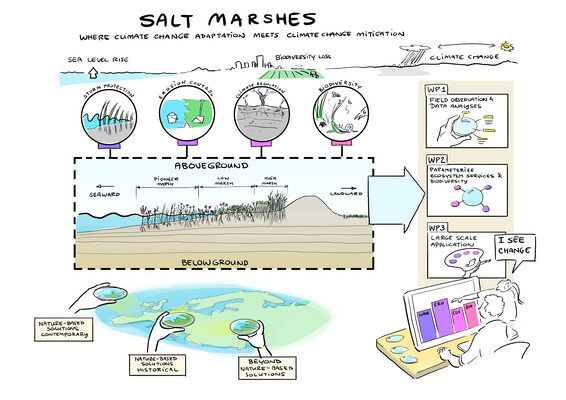P.W.J.M. Willemsen1,2*, A.J.F. Hoitink1
1 Hydrology and Environmental Hydraulics, Wageningen University and Research, Netherlands; 2 Department of Ecosystems and Sediment Dynamics, Deltares, the Netherlands
* Corresponding author: pim.willemsen@wur.nl
Introduction
Global society is facing the intertwined crises of climate change and biodiversity loss1. Over the last decade, Nature-based Solutions (NbS) with salt marshes have globally been recognized as a solution to adapt to and mitigate climate change by providing regulating ecosystem services (ES), while preserving biodiversity. However, constructed or supported salt marshes in NbS develop differently than natural marshes. NbS pilot projects only appeared in the last decade, so there is limited knowledge about the fundamental long-term development and functioning. So, comprehensive assessments quantifying ES in NbS with salt marshes are sparse and field-based evidence is missing. Furthermore, while there are synergies and trade-offs between ES2,3. ES for adaptation and mitigation are generally not integrated in a multi-service approach. These combined knowledge gaps impede the effective design and management of NbS with salt marshes. To address these contemporary knowledge gaps, this research project aims to:
Understand and quantify the fundamental relation between marsh development and ES to define guidelines for NbS with salt marshes that enable climate change adaptation and mitigation, by:
1. quantifying (in)organic aboveground and belowground development of salt marshes; and
2. assessing the magnitude, synergies and trade-offs of combined ES and biodiversity.
Objective and Methods
Quantitative field-evidence on the long-term development and functioning of salt marshes (WP1; Figure) will be used to inform a multidisciplinary approach to ES and biodiversity synergies and trade-offs (WP2). This knowledge will be combined in a surrogate model to explore the larger-scale application of NbS with salt marshes for climate change adaptation and mitigation (WP3).
To quantify the long-term (in)organic development of historical NbS over a decadal timescale, data of the past 50 years will be used (WP1). A database will be built based on existing long-term biophysical data of the marshes including elevation maps, marsh zonation and extent and sedimentation/erosion data4. This database will be extended with field measurements from study sites covering the landscape gradient from the seaward to the landward side of the dike.
Individual ES will be quantified based on the WP1 database, focusing on: storm protection, erosion control, climate regulation and biodiversity. A cultural biography5 (i.e. timeline) will be reconstructed for the development of historical NbS. This information enables the identification of changes in NbS construction and adaptive management and associated (in)organic development of historical NbS.
Results
The impact of future climate change scenarios on NbS development and its associated ES will be simulated using the numerical model Delft3D Flexible Mesh6. Using process-based model predictions and parameterizations from WP1 and WP2, a surrogate model will be used to show salt marsh development, related ES, biodiversity and their trade-offs and synergies.
The model results will be used to quantify long-term ES of NbS. This enables the quantification of NbS guidelines from a biophysical and cultural-historical perspective enabling application of NbS for combined climate change adaptation and mitigation, while preserving biodiversity.
The research plan will be presented during the NCK-Days 2025 to receive feedback and better integrate the study in the NCK community.
This research is funded by NWO Talent Programme, VENI-AES 2023 (21063). Collaboration partners are Deltares, Ecoshape, Wageningen Environmental research, State Agency for Coastal Protection - National Park and Marine Conservation Schleswig-Holstein, Wageningen Marine Research, University of Groningen, University of Twente, Leibniz University Hannover, DEME, US Army Corps of Engineers, Sun Yat-Sen University.

Graphical abstract of the research project
References
[1] UNFCCC. (2022). What is the Triple Planetary Crisis? Retrieved from https://unfccc.int/news/what-is-the-triple-planetary-crisis
[2] van Loon-Steensma, J. M., & Vellinga, P. (2013). Trade-offs between biodiversity and flood protection services of coastal salt marshes. Current Opinion in Environmental Sustainability, 5(3), 320-326. doi:https://doi.org/10.1016/j.cosust.2013.07.007
[3] Auerswald, K., Moyle, P., Seibert, S. P., & Geist, J. (2019). HESS Opinions: Socio-economic and ecological trade-offs of flood management – benefits of a transdisciplinary approach. Hydrol. Earth Syst. Sci., 23(2), 1035-1044. doi:10.5194/hess-23-1035-2019
[4] Elschot, K., Van Puijenbroek, M., Lagendijk, G., Van der wal, J.-T., & Sonneveld, C. (2020). Lange-termijnontwikkeling van kwelders in de Waddenzee (1960-2018).
[5] Conijn, A. (2020). Changing mentalities on flooding in the Upper Thine valley landscape : An interdisciplinary landscape study on the role of changing flood perception on the emergence of its management in the Upper Rhine valley.
[6] Willemsen, P. W. J. M., Smits, B. P., Borsje, B. W., Herman, P. M. J., Dijkstra, J. T., Bouma, T. J., & Hulscher, S. J. M. H. (2022). Modeling Decadal Salt Marsh Development: Variability of the Salt Marsh Edge Under Influence of Waves and Sediment Availability. Water Resources Research, 58(1), e2020WR028962. doi:https://doi.org/10.1029/2020WR028962


